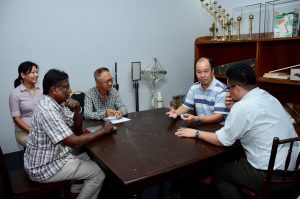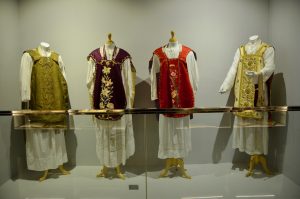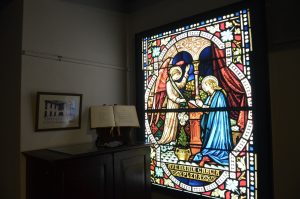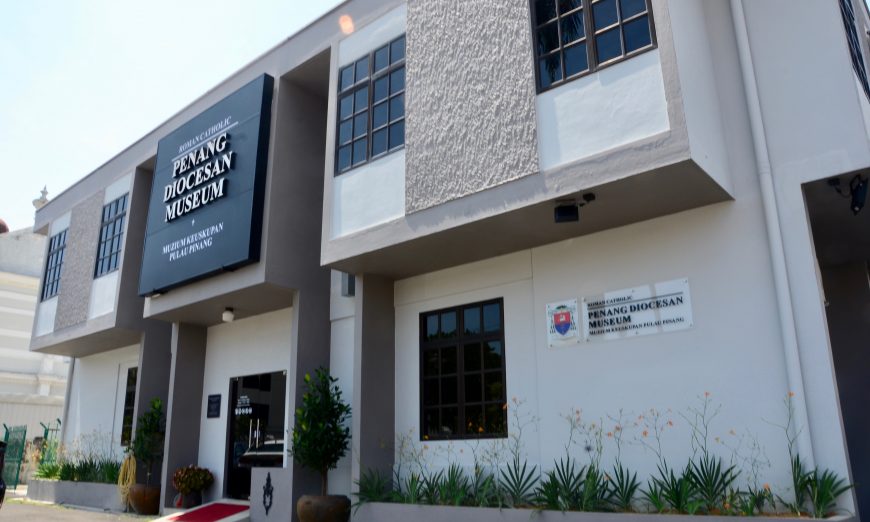Story by Victor Seow
Pix by Alissala Thian

THE newly restored 158-year-old Church of the Assumption along Farquhar Street reopened its doors to the public and its parishioners on Jan 1 this year. Apart from being brought back to the condition it was back in 1928, an added feature is the Roman Catholic Diocesan Museum which now occupies what used to be the Bishop’s office within the compound of the church.
Having some sort of a museum to store and safeguard traditional Catholic paraphernalia has always been close to Msgr Father Michael Cheah’s heart who first mooted the idea not long after he was ordained as a priest and entered the seminary in 1989 at the age of 33.
“I noticed many things that we might not be using but are very precious to us such as the sacred vessels and so on. We lost many things such as furniture and artefacts because we were always shifting around and no one was aware of the precious things we had (which belonged to the Church). It was not so much about the monetary value but more of the heritage and tradition that were being lost,” Fr Michael told Buletin Mutiara.

The Roman Catholic Penang Diocesan Museum finally came to fruition due to Fr Michael’s vision and persistence over the years in pursuing his goal of having a museum for the Diocesan in the northern region which ultimately won the approval of the current Bishop of Penang Rev. Datuk Sebastian Francis in 2015.
“Why we have this (museum)? Firstly, to at least record historically the foundation of the Church here in Penang which is the Penang Diocese which covers the five northern states.
“Secondly, it is to make known to the public that we are neither evangelizing nor propagating our religion. We just want to record the heritage and culture of the Church which many of our Catholics and even some priests do not know.
“It is also about community communion so that when people (of different faiths) understand each other more, there will be greater harmony.
“And of course, thirdly, to preserve the beautiful artefacts which sometimes we can’t buy now even if we have the money. For example, some of the churches may no longer exist but we still have the sacred vessels from such churches like when the main altar of Convent Light Street was renovated, many items were distributed but we managed to get them back together after 20 years.
“If we do not make this effort, we will lose many of these heritage items of the Church. If people do not have any interest, they would just discard (such priceless items of the Church). And I think many of our candle stands ended up in antique shops. I was once heartbroken when I was at Manila Airport standing in an antique shop where there were sacred vessels (for sale). Sacred vessels should never be for public use. These items should always be in a church or kept in a museum because sacred vessels were blessed,” he noted.
Fr Michael is also very appreciative of the services rendered by Khoo Boo Chia, the curator for the Roman Catholic Diocesan Museum. Retiree Khoo was formerly the curator for the Penang State Museum and is now happily providing his expertise in the areas of the interior arrangement of the artefacts and promotional strategies for the further development of the museum.

“We currently don’t expect too many visitors because the museum is still fairly new. For the moment, we do have walk-in visitors. And given that this is a religious museum, it is not something of public interest but more specialised for the Catholic community,” said Khoo.
“Every museum needs to have its marketing strategies such as printing of brochures for publicity. Nowadays, we also have cruise ships coming in and we are looking into ways to tie up with the agents to get them to bring visitors here like what Khoo Kongsi (clan house) is doing.
“On average, we have around 20 plus visitors a day and on a good day, about 60 plus. In terms of museum technology, we are also trying to make this museum as computer savvy as possible in order to attract young people. We hope this museum could be turned into a Catholic Resource Centre in future,” added Khoo.
The opening hours of the Roman Catholic Diocesan Museum:
Mon – Fri (10am – 5pm)
Sat (9am – 1pm)
Closed on Sundays & public holidays
Entry is by donation.

